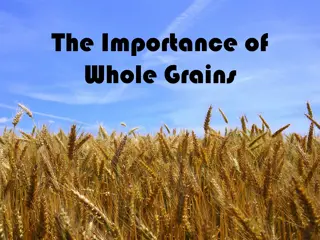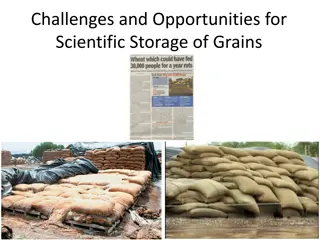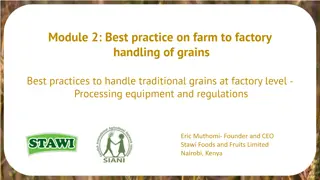Precautions for Safe Storage of Grains
Coping with the demand for food grains requires reducing post-harvest losses during storage. Learn about cleaning, drying, and maintaining storage structures to ensure safe and effective grain storage. Different types of storage structures and their capacities are also discussed.
Download Presentation

Please find below an Image/Link to download the presentation.
The content on the website is provided AS IS for your information and personal use only. It may not be sold, licensed, or shared on other websites without obtaining consent from the author.If you encounter any issues during the download, it is possible that the publisher has removed the file from their server.
You are allowed to download the files provided on this website for personal or commercial use, subject to the condition that they are used lawfully. All files are the property of their respective owners.
The content on the website is provided AS IS for your information and personal use only. It may not be sold, licensed, or shared on other websites without obtaining consent from the author.
E N D
Presentation Transcript
Introduction To cope with the current and future demand of the increasing population for the food grains, it is emphasized to reduce the loss of seeds during and after harvest. Seeds are stored for varying periods to ensure proper and balanced public distribution throughout the year. Post-harvest losses in India are estimated to be around 10 per cent, of which the losses during storage alone are estimated to be 6.58 per cent.
Best storage performance 1. The produce must be thoroughly cleaned and graded. 2. Dried to the safe storage moisture level of 10-12 % for cereals and 7-9% for oilseeds (on wet basis) for a safe storage period of 6-12 months. 3. Storage structures should to be properly repaired, cleaned and disinfected. 4. Structures should bear the load of seeds stored and do not permit contact/ exchange with outside humid air. 5. Structures should be constructed in the coolest part of the house/ farm.
Ideal storage facility should satisfy the following requirements 1. It should provide maximum possible protection from ground moisture, rain, insect pests, moulds, rodents, birds, fire etc., 2. It should provide the necessary facility for inspection, disinfection, loading, unloading, cleaning and reconditioning. 3. It should protect grain from excessive moisture and temperature favourable to both insect and mould development. 4. It should be economical and suitable for a particular situation.
STORAGE STRUCTURES Different types storage structures 1. Conventional storage structures 2. Improved rural - level storage structures 3. Community storage structures
Structure Make Stored Capacit Remarks s items y 1. Split bamboo woven Paddy, 500 kg Life 4-5 years. Weight Bamboo in the form of a wheat and loss due to insect attack structures cylinder with wide sorghum is 5 % in paddy and 15% base and narrow in sorghum. mouth Clay, straw and cow 2. Mud Paddy, 5 to 10 q Life 8- 10 years. During and dung- 3:3:1. Earthen wheat, rainy season develop earthen structures are made, sorghum,oi cracks and moisture structures sun dried and then l seeds absorption followed by burnt in fire and pulses insect and mould
Bamboo structures Mud and earthen structures
3. Wooden Local wood is painted black. At Paddy 10 q 15- 20 years. structures the top, 30 cm x 20 cm in let and Neither airtight at the bottom 30 cm x15cm outlet nor moisture is provided. proof. 4. Brick Rectangular, structures built as Paddy, 25- 30 q25- 30 years. structures part of the house, with brick in sorghum High initial cost, cement or lime mortar having a and wheat not insect and wall thickness of 40 50 cm. At moisture proof. the top 50x 50 cm inlet and at bottom 15 x15cm outlet is provided.
Brick structures Wooden structures
5.Underground Circular pits vary from 100 Cereals 100 Safe against structures 400cm in depth and 50 100 200 q insects but, loss cm dia at neck and 250 300 of seed viability cm at the bottom. For filling and and handling emptying there is an opening at difficulties made the top. Before filling the sides it out of date. and bottom are packed with straw and husk. After filling the pit is again covered with straw and stone, the finally with mud.
6.Miscellaneous a. paddy straw is Paddy, other 30 100q Not insect and plant materials wound in the form of cereals and rat proof a. Paddy straw rope to varying pulses b. Stem of vitex diameter 1-2 q Temporary and pigeon pea b. stems wound like a Paddy and other stalks bin and both sides are cereals c. Bottle gourd plastered with mud 2-5 kg Only shells and cow dung small quantity c. empty shells are Pulses, gourd of seed lots. used seeds
7. Metal Sheets of about 3 m high are held Various Vary Vary corrugated vertically along one edge and edges types of Temporary G.I. of the other sheets are overlapped seeds sheets and bolted to each other. Thus the circle with 2-4 m dia. It is completed with many such sheets. They are covered on the top with the plain M.S. or G.I. sheets. 8. Hessian cloth bags 9. Gunny bags























